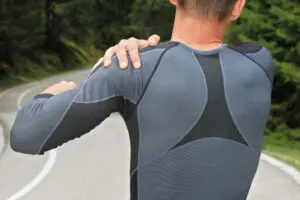When people start to experience chronic pain in their joints, especially their shoulder, surgery is what comes to mind. Tears, tendinitis and impingement are all words that sound pretty intimidating and need surgical intervention. However, most cases of shoulder pain are treated non-surgically. This means we prescribe a combination of medicine, physical therapy and sometimes injection therapy.
 Types of Injections
Types of Injections
In recent decades, injection therapy has become more popular, and a really good alternative to surgery. There are two types of injections we use:
Cortisone Shots – Just as you may take ibuprofen for general aches and pains, a cortisone shot acts as a local anti-inflammatory for a painful body part. The key difference is that the cortisone acts mainly at the site of injection.
Platelet-Rich (PRP) Therapy Injection – This injection utilizes the natural ability for platelets to heal tissue. Rather than strictly anti-inflammatory pain management, this therapy helps to actually promote healing in the shoulder.
How Does PRP Work?
When you get a scab after a wound, much of that is the result of the work of platelets in your blood. Platelets are cells in your blood that are best known for clotting. However, they have a lot of other healing properties that can help stimulate tissue growth. The growth factors that the platelets secrete stimulate tissue recovery by increasing collagen production, enhancing tendon stem cell proliferation, and tenocyte-related gene and protein expression.
So injecting PRP into damaged shoulder tissue or ligament helps to promote healing in your shoulder just as platelets would heal a wound. This is even more enhanced by the fact that PRP is a concentrated formula of plasma with many more platelets than what is typically found in blood.
Is This Ongoing Therapy?
Although there is case by case variability, we offer patients a series of two to three injections a week apart. It’s not as intensive and ongoing as physical therapy and some patients even experience tremendous improvement after 1 session.
After you have your PRP injection you may experience an increase in pain in the days immediately following. You will notice gradual improvement 2-6 weeks after starting the PRP therapy. Some patients report ongoing improvement 6-9 months after PRP therapy is administered.
If you are experiencing ongoing shoulder pain and were afraid you would need serious surgery, you should schedule an appointment with Dr. Koo. He will do a workup to determine the severity of your case, and chances are you can be healed non-surgically.

 Types of Injections
Types of Injections

